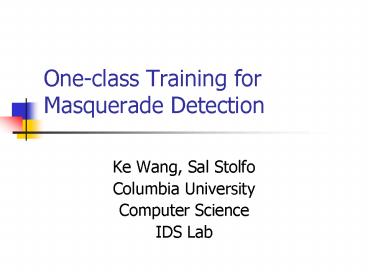One-class Training for Masquerade Detection - PowerPoint PPT Presentation
Title:
One-class Training for Masquerade Detection
Description:
Each block is N-dimensional binary feature vector. N is the number of unique ... Each 1 dimension is a Bernoulli, the whole vector is multivariate Bernoulli. ... – PowerPoint PPT presentation
Number of Views:45
Avg rating:3.0/5.0
Title: One-class Training for Masquerade Detection
1
One-class Training for Masquerade Detection
- Ke Wang, Sal Stolfo
- Columbia University
- Computer Science
- IDS Lab
2
Masquerade Attack
- One user impersonates another
- Access control and authentication cannot detect
it (legitimate credentials are presented) - Can be the most serious form of computer abuse
- Common solution is detecting significant
departures from normal user behavior
3
Schonlau Dataset
- 15,000 truncated UNIX commands for each user, 70
users - 100 commands as one block
- Each block is treated as a document
- Randomly chose 50 users as victim
- Each users first 5,000 commands are clean, the
rest have randomly inserted dirty blocks from the
other 20 users
4
Previous work
- Use two-class classifier self non-self
profiles for each user - First 5,000 as self examples, and the first 5,000
commands of all other 49 users as masquerade
examples - Examples Naïve Bayes Maxion, 1-step Markov,
Sequence Matching Schonlau
5
Why two class?
- Its reasonable to assume the negative examples
(user/self) to be consistent in a certain way,
but positive examples (masquerader data) are
different since they can belong to any user. - Since a true masquerader training data is
unavailable, other users stand in their shoes.
6
Benefits of one-class approach
- Practical Advantages
- Much less data collection
- Decentralized management
- Independent training
- Faster training and testing
- No need to define a masquerader, but instead
detect impersonators.
7
One-class algorithms
- One-class Naïve Bayes (eg., Maxion)
- One-class SVM
8
Naïve Bayes Classifier
- Bayes Rule
- Assume each word is independent (the Naïve part)
- Compute the parameter during training, choose the
class of higher probability during testing.
9
Multi-variate Bernoulli model
- Each block is N-dimensional binary feature
vector. N is the number of unique commands each
assigned an index in the vector. - Each feature set to 1 if command occurs in the
block, 0 otherwise. - Each 1 dimension is a Bernoulli, the whole vector
is multivariate Bernoulli.
10
Multinomial model (Bag-of-words)
- Each block is N-dimensional feature vector, as
before. - Each feature is the number of times the command
occurs in the block. - Each block is a vector of multinomial counts.
11
Model comparison (McCallum Nigam 98)
12
One-class Naïve Bayes
- Assume each command has equal probability for a
masquerader. - Can only adjust the threshold of the probability
to be user/self, i.e. ratio of the estimated
probability to the uniform distribution. - Dont need any information about masquerader at
all.
13
SVM (Support Vector Machine)
14
One-class SVM
- Map data into feature space using kernel.
- Find hyperplane S separating the positive data
from the origin (negative) with maximum margin. - The probability that a positive test data lies
outside of S is bounded by a prior v. - Relaxation parameters allow some outliers.
15
One-class SVM
16
Experimental setting (revisited)
- 50 users. Each users first 5,000 commands are
clean, the rest 10,000 have randomly inserted
dirty blocks from other 20 users. - First 5,000 as positive examples, and the first
5,000 commands of all other 49 users as negative
examples.
17
Bernoulli vs. Multinomial
18
One-class vs. two-class result
19
ocSVM binary vs. previous best-outcome results
20
Compare different classifiers for multiple users
- Same classifiers have different performance for
different users. (ocSVM binary)
21
Problem with the dataset
- Each user has a different number of masquerade
blocks. - The origins of the masquerade blocks also differ.
- So this experiment may not illustrate the real
performance of the classifier.
22
Alternative data configuration 1v49
- Only first 5,000 commands as user/selfs examples
for training. - All other 49 users first 5,000 commands as
masquerade data, against those clean data of
selfs rest 10,000 commands. - Each user has almost the same masquerade block to
detect. - Better method to compare the classifiers.
23
ROC Score
- ROC score is the fraction of the area under the
ROC curve, the larger the better. - A ROC score of 1 means perfect detection without
any false positives.
24
ROC Score
25
Comparison using ROC score
26
ROC-P Score false positiveltp
27
ROC-5 fplt5
28
ROC-1 fplt1
29
Conclusion
- One-class training can achieve similar
performance as multiple class methods. - One-class training has practical benefits.
- One-class SVM using binary feature is better,
especially when the false positive rate is low.
30
Future work
- Include command argument as features
- Feature selection?
- Real-time detection
- Combining user commands with file access, system
call































